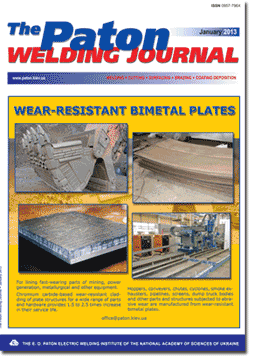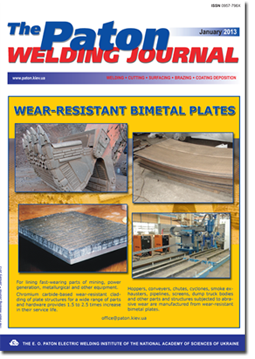Access for download PDF files for subscribers and for reviewers of scientometric bases.
Organization: Elsevier for content access(PDF files of journals released before 2024 are available for download from the website's archives))
Organization: Elsevier for content access(PDF files of journals released before 2024 are available for download from the website's archives))
| 2013 №01 (07) | 2013 №01 (09) |

The Paton Welding Journal, 2013, #1, 39-43 pages
TRANSVERSE MAGNETIC FIELD INPUT DEVICES FOR ARC WELDING AND SURFACING PROCESSES (Review)
A.D. RAZMYSHLYAEV, M.V. MIRONOVA and S.V. YARMONOV
Priazovsky State Technical University of the Ministry of Education and Science of Ukraine, Mariupol, Ukraine
Abstract
Application of controlling longitudinal and transverse magnetic fields is promising in arc welding and surfacing, allowing improvement of efficiency of electrode wire melting, refining of the structure of weld metal (deposited bead) and reducing the depth of base metal penetration. In arc welding and surfacing the influence of transverse magnetic fields on geometrical dimensions of welds (beads) and electrode melting efficiency was mainly determined. These works either do not give the input device designs, or they are presented without discussion of the subject of optimality of the used designs, or dimensions of each element of these devices. The objective of this work was analysis of known designs of input devices to assess the effectiveness of their application in arc welding and surfacing. It is shown that the devices described in publications consist of an electric magnet with P-shaped ferrite core with an air gap and windings. In some works just the transverse component of magnetic field Bx was measured, and longitudinal component of induction Bz induced by the applied input device, was not measured. However, the shape and dimensions of the cross-section of welds and deposited beads in this case could be influenced not only by transverse Bx, but also by longitudinal component of magnetic field Bz. Design features, as well as distribution of induction components Bx, Bz generated by known circuits of devices for application of transverse magnetic fields in the zone of welding arc and pool, were analyzed, and their disadvantages were noted. Urgency of development of new circuits is shown, as well as rationality of optimization of structural dimensions of known circuits of the devices to improve the effectiveness of arc welding and surfacing with application of transverse magnetic fields. 15 Ref., 5 Figures.
Keywords: arc welding and surfacing, longitudinal and transverse magnetic field, magnetic field induction, input device for transverse magnetic field application
Received: 24.10.12
Published: 28.01.12
References
1. Chernysh, V.P., Kuznetsov, V.D., Briskman, A.N. et al. (1983) Welding with electromagnetic stirring. Kiev: Tekhnika.
2. Chernysh, V.P., Kukhar, S.N. (1984) Equipment for welding with electromagnetic stirring. Kiev: Vyshcha Shkola.
3. Razmyshlyaev, A.D., Maevsky, V.R., Sidorenko, S.M. (2001) Calculation of magnetic field induction of a solenoid with a ferromagnetic core for arc surfacing. The Paton Welding J., 8, 18-21.
4. Demiinsky, Yu.A., Dyatlov, V.I. (1963) Magnetic control in consumable electrode gas-arc welding. Avtomatich. Svarka, 4, 82-83.
5. Akulov, A.I., Kopaev, B.V. (1972) Magnetic control of the arc in argon metal-arc welding. Ibid., 7, 39-42.
6. Boldyrev, A.M., Tkachenko, Yu.S., Tolokonnikov, N.P. et al. (1975) Refining of weld metal structure in welding with arc oscillating in transverse magnetic field. Ibid., 7, 70-71.
7. Gagen, Yu.G., Perun, I.V., Dobrovolsky, S.T. et al. (1975) Magnetic control of weld formation in automatic submerged-arc welding. Ibid., 11, 73-74.
8. Demyantsevich, V.P., Lebedev, G.A., Maksimets, N.A. (1975) Influence of external magnetic field and welding parameters on weld formation. Svarochn. Proizvodstvo, 11, 7-9.
9. Razmyshlyaev, A.D. (1994) Control of weld geometry in arc welding and surfacing under the action of magnetic fields (Review). Ibid., 9, 28-31.
10. Shejnkin, M.Z., Shmeleva, I.A., Varyakhov, N.F. (1969) Application of magnetic oscillations in submerged-arc welding. Ibid., 6, 24-25.
11. Patskevich, I.R., Zernov, A.V., Ivantsov, V.Ya. (1970) Distribution of induction of induced magnetic field in the zone of welding arc running. Ibid., 2, 9-10.
12. Iofinov, P.A., Ibragimov, V.S., Dmitrienko, A.K. et al. (1991) Influence of external electromagnetic field on the rate of electrode wire melting in automatic submerged-arc surfacing. Ibid., 1, 34-35.
13. Razmyshlyaev, A.D., Maevsky, V.R. (1996) Effect of controlled magnetic field on weld geometry in automatic submerged-arc welding. Ibid., 2, 17-19.
14. Razmyshlyaev, A.D. (2000) Magnetic control of weld formation in arc welding. Mariupol: PGTU.
15. Razmyshlyaev, A.D., Mironova, M.V., Kuzmenko, K.G. et al. (2011) Efficiency of melting of electrode wire in submerged-arc surfacing with influence of transverse magnetic field. The Paton Welding J., 5, 39-42.
Suggested Citation
A.D. RAZMYSHLYAEV, M.V. MIRONOVA and S.V. YARMONOV (2013) TRANSVERSE MAGNETIC FIELD INPUT DEVICES FOR ARC WELDING AND SURFACING PROCESSES (Review). The Paton Welding J., 01, 39-43.The cost of subscription/purchase order journals or individual articles
| Journal/Currency | Annual Set | 1 issue printed |
1 issue |
one article |
| TPWJ/USD | 384 $ | 32 $ | 26 $ | 13 $ |
| TPWJ/EUR | 348 € | 29 € | 24 € | 12 € |
| TPWJ/UAH | 7200 UAH | 600 UAH | 600 UAH | 280 UAH |
| AS/UAH | 1800 UAH | 300 UAH | 300 UAH | 150 UAH |
| AS/USD | 192 $ | 32 $ | 26 $ | 13 $ |
| AS/EUR | 180 € | 30 € | 25 € | 12 € |
| SEM/UAH | 1200 UAH | 300 UAH | 300 UAH | 150 UAH |
| SEM/USD | 128 $ | 32 $ | 26 $ | 13 $ |
| SEM/EUR | 120 € | 30 € | 25 € | 12 € |
| TDNK/UAH | 1200 UAH | 300 UAH | 300 UAH | 150 UAH |
| TDNK/USD | 128 $ | 32 $ | 26 $ | 13 $ |
| TDNK/EUR | 120 € | 30 € | 25 € | 15 € |
AS = «Automatic Welding» - 6 issues per year;
TPWJ = «PATON WELDING JOURNAL» - 12 issues per year;
SEM = «Electrometallurgy Today» - 4 issues per year;
TDNK = «Technical Diagnostics and Non-Destructive Testing» - 4 issues per year.


